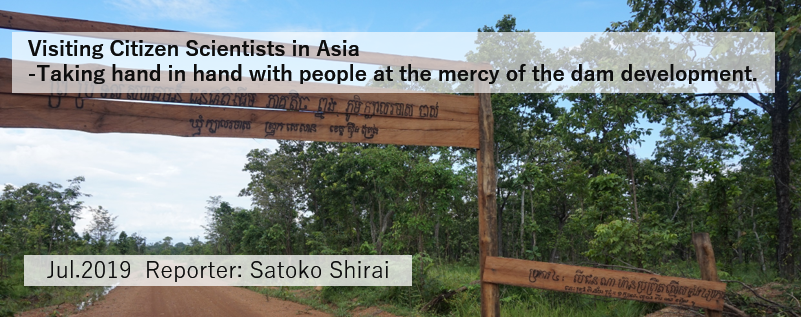
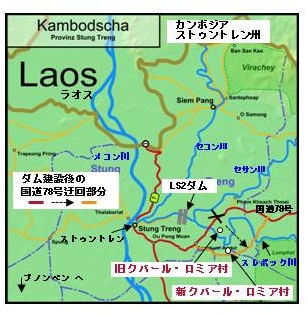 |
Introduction
Throughout the 26th of June and the 9th of July, 2019, I visited Vietnam, Indonesia, and Cambodia to encourage the recipient countries this year (the 18th term). Today, I would like to introduce Cambodia. The recipient of the Cambodian grant is the My Village LS2 Community Action Research Team ('MV' from the following), under the theme "Local Knowledge Acquisition: Monitoring the Impact of the Lower Sesan 2 Dam ('LS2 Dam' from the following)".
I had a further look into the livelihood issues (mostly indigenous people) affected due to the dam constructed downstream of the Sesan area of the Mekong River branch. Along with their impacts on the river ecosystems, and support them so that they can negotiate with relevant authorities and make policy decisions on what needs to be improved.
Arrival at Stung Treng
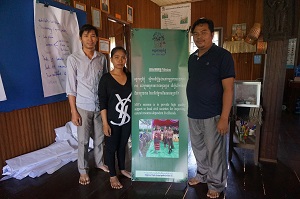 at the MVi office |
Several villages had forced to relocate due to the construction of the LS2 dam, but this time I visited the settlement of Kuvar Romia, one of the three places supported by MV. In fact, this village has divided itself into two parts: the new district where residents have agreed to relocate, and the old district where people refuse to relocate and who kept staying in the place where they originally lived. Therefore, the prior is called “New Kuvar Romia” and the “Old Kuvar Romia” for the following. MV regularly visits each district and participates in residents’ meetings to hear the current situation (the progress of compensation, problems, etc.). This time, I was able to stop by both districts because they arranged the opportunity for me as a part of their visit.
The New Kuvar Romia
The first stop was New Village, where the relocation began in 2014, with the dam construction, and at the time of the visit, 72 families were living. As the place to move to, it was a planned village, so the house structure was almost the same, and the raised-floor houses had arranged at regular intervals on the fresh blue roof (Bottom Left), which gave me the impression of being orderly. When I arrived at the dwelling, which was to be the meeting place, the residents and the members of the youth group of the area gathered one after another. By surrounding the map of the whole community (Bottom picture right), they reported on the progress of compensation and current issues. The main questions that have been asked at the meeting were as follows.
- As it is difficult to secure drinking water during the dry season, the residents have asked the government to install rainwater tanks.
-Due to the dam construction, the village was separated, and the quantity of children is little and only elementary schools are functioning.
- Medical institutions must be used in other villages.
-Since the construction of the dam, a rapid rise in water level has occurred in a short period of time during the rainy season. However, the alarm system is not linked, so they are having an uneasy time.
- The kinds and quantities of fish caught have changed. (Investigation by the MV is still going on)
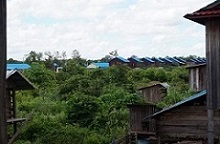 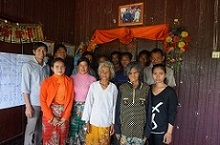 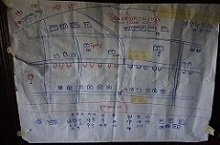 The New Kuvar Romia |
The Old Kuvar Romia
After a lunch break, we drove about 1 ~ 2 hours from the New Kuvar Romia to Old Kuvar Romia. As I entered the narrow road from the main street to the community, individual houses of various sizes diverged over enough distance. Considering that the new address I visited before was facing the main street, I could understand why many people said, "I don't want to move because the new place is narrow and cramped." as the air was calm and relaxed.
Old Village has 52 families. Considering the commencement of the dam construction, they were isolated, being "to remain in the area around the dam in protest of the relocation" and not only excluded from the framework of compensation but also denied essential public services. With the support of MVs, residents have informed relevant authorities at national and local levels of these issues and negotiated to act. In early 2017, the state finally sent a notice saying that it would not be responsible for compensation to those who refused to relocate. The residents then sent a wrap back to the state governor asking him to accept compensation responsibly. In October, the governor finally met with the residents.
The five main points were requested: 1. Land registration, 2. Road repair, 3. School education, 4. Drinking water provision (well drilling), and 5. Medical services, all of which are available before the development, and which requested as to a natural right.
Due the discussion, various measures were promised and agreed upon, and living in the area was officially approved. A little less than 10 months later, the hearing revealed that what was promised was still in the middle of the path and that there were still many issues to be addressed. However, considering that this agreement eliminated police checkpoints and enabled NGOs supporting the community to enter the area openly, it may be said that this was a turning point.
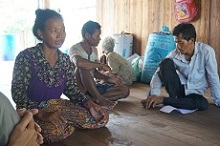 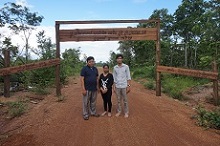 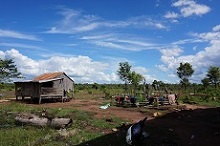 The Old Kuvar Romia |
Conclusion
The Cambodian government, which is becoming more dictatorial, has taken drastic steps to dissolve all the forces that are critical of the government (opposition, media, NGOs, etc.), so the NGOs that are officially present in Cambodia at this time, might be an organization that is in a close position or that survives in a "wise" way.
Regarding the issue of the forced relocation of residents brought about by the LS2 dam, there seems to be some harsh criticism against NGOs, saying, "The reason why the main goal of stopping dam construction, which was initially the goal of many residents, was changed to negotiations for better compensation, was probably due to the NGOs, which were supposed to represent the residents, manipulated the residents instead." However, under the dictatorship, I had the impression that NGOs were struggling to find what they could do while there was no real option to oppose the national project of dam development. When I asked a MV staff about this, he said, "Residents will be in trouble if we are unable to engage in (under government scrutiny) activities. We respect the community and remain a facilitator. Old village residents, for example, chose not to relocate. We have observed the debate over what they want to do as a village in line with that decision, and if they want to request the government, we will provide support to convey it effectively, and if they want to spread their voice widely, we will use independent media to help. We're always on the other side of the fence, and we don't go out there."
There is a town named Kratie which is famous for the habitat of river dolphins in the south of Stung Treng. There a new plan made to construct the Sanbo Dam (Capacity of 2600 MW) in the vicinity. Since it is much larger than the LS2 dam (400 MW), many NGOs are concerned about the impact and are shifting their resources to the Sanbo Dam. It can be said that it is a natural trend for NGOs to direct limited resources to sites with a high degree of urgency. However, many of the affected residents in the area surrounding the LS2 dam felt left behind in this "withdrawal". Indeed, now that the LS2 has been completed and is in operation, the demand of residents has shifted from the initial "opposition to dam construction" to "Discussing compensation and improving the quality of life" and there may not be any work left to create impact as an NGO. Therefore, steady efforts by local NGOs, such as MV, to support and stay close to people in affected areas are significant. On the other hand, it is easy to imagine that dam construction on a much larger scale than LS2 dam would have a considerable impact on watershed ecosystems and the lives of residents if it were to be carried out from a global perspective. It goes without saying how important it is to address this issue.
Toshiyuki Doi from Mekong Watch, an international NGO, which has been working on the LS2 dam issue for a long time, said, "There is a remorse that NGOs were unable to take strategic action on the LS2 dam issue. As a lesson from this, the focus of attention for the future is likely to be whether it will lead to the prevention of Sanbo Dam." I would like to see how much of the sacrifices made for dam construction in the past, including the LS2 dam, can be applied to a huge dam project that is likely to start operating any time soon.
During my visit to Cambodia this time, I was indebted to Mr. Toshiyuki Doi of the international NGO Mekong Watch, as well as Kol Leakhana from Phnom Penh. I'd like to take this opportunity to thank them.
